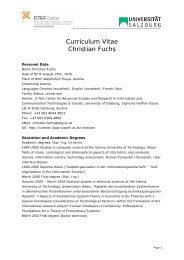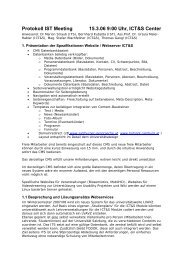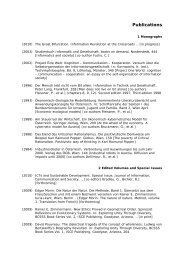ICTS AND SOCIETY: THE SALZBURG APPROACH - ICT&S
ICTS AND SOCIETY: THE SALZBURG APPROACH - ICT&S
ICTS AND SOCIETY: THE SALZBURG APPROACH - ICT&S
Create successful ePaper yourself
Turn your PDF publications into a flip-book with our unique Google optimized e-Paper software.
ICTs and Society: The Salzburg Approach<br />
• in the area of communication, that is, where common understanding is<br />
produced by interactions (individuals),<br />
• in the area of cooperation, that is, where sense embodied in societal structures<br />
is produced collectively by individuals who act in balanced ways.<br />
The first and second areas go without saying, with cognitive science and communication<br />
studies as well-known fields of scientific activity. It is the third area that<br />
proves unconventional, as it contests a strong tradition in humanities that qualifies<br />
society as composed of communications only. Niklas Luhmann stands for this tradition.<br />
Introducing cooperation does, actually, justice to the “social facts” Emile Durkheim<br />
considered the proper object of sociology, to the “social relationships” Karl<br />
Marx distinguished from “social behaviour”, to the “structure” that was focused on<br />
by the structuralist school after Marx, to the “synergy effects” that today can be<br />
investigated by science-of-complexity methods. That is, it does justice to the phenomenon<br />
that there is more to society than only communication on the level of interaction<br />
of individuals and that this whole – which is more than the sum of communications/interactions<br />
– is an information process too, albeit on the level of a<br />
social organisation.<br />
Hence we can say, ICT&S Research – insofar as ICTs are technologies for mediating<br />
human information processes – comprises human cognition processes, human communication<br />
processes, and human cooperation processes. All three of them are, in<br />
a way, normative: cognition has the objective to position the individual vís-a-vís the<br />
societal, social, and nonhuman environment; communication aims at finding a state<br />
of mutual understanding between individuals on whatever matter it may be; and<br />
cooperation has a goal – that of a state of organisation of individuals that allows<br />
for a mutually beneficial common outcome. As a consequence, cognitive science,<br />
communication studies, and cultural studies, social science and the like insofar as<br />
dealing with the added value are sciences that inquire into human information<br />
processes. And ICT&S Research needs all of them, since it deals with the technological<br />
mediation of these societal functions which are interrelated in a specific<br />
way: in order to cooperate you need to communicate and in order to communicate<br />
you need to cognise.<br />
ICTs as “tools for thought” as Howard Rheingold (1993, 2002) interprets the vision<br />
of the computer pioneer J.C.R. Licklider (see e.g. Licklider and Taylor 1968), serve<br />
the cognitive function. As a medium they serve the communicative function. And as<br />
“technologies for cooperation” they serve the cooperative function. For each perspective,<br />
there is a leading discipline: Human Computer Interaction (HCI) for the first<br />
one, Computer Mediated Communication (CMC) for the second one, and Computer<br />
Supported Cooperative Work (CSCW) for the third one. ICT&S Research has to build<br />
upon all of them, for in the search of the bigger picture it concentrates on the interrelations<br />
between them (see Fig. 8).<br />
Hofkirchner | Fuchs | Raffl | Schafranek | Sandoval | Bichler 34









